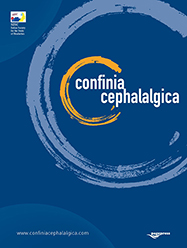Prospective evaluation of aura during anti-calcitonin gene-related peptide monoclonal antibody therapy after 52 weeks of treatment

All claims expressed in this article are solely those of the authors and do not necessarily represent those of their affiliated organizations, or those of the publisher, the editors and the reviewers. Any product that may be evaluated in this article or claim that may be made by its manufacturer is not guaranteed or endorsed by the publisher.
Accepted: 10 April 2024
Authors
Background: Clinical studies have shown the efficacy and safety of monoclonal antibodies (mAbs) against calcitonin gene-related peptide (anti-CGRP) in migraine patients with and without aura. Early evidence from post hoc and small subgroup analyses suggests that anti-CGRP mAbs reduce the frequency and intensity of aura. Herein, we prospectively assessed the changes in aura after 12 months of anti-CGRP mAb treatment and performed a literature review.
Methods: All outpatients treated with anti-CGRP mAbs for one year in two tertiary Headache Centers and who experienced ≥1 episode of aura/month were enrolled. The study reports data from one month before (baseline) and the last three months (months 10, 11, 12) of treatment.
Results: Data from 13 patients with a diagnosis of migraine with and without aura were collected. The mean duration from aura onset was 17.8±7.9 years. At baseline nine patients (69.2%) reported visual aura, and four (30.8%) visual and sensory aura. Mean duration of aura episodes was of 34.2±15.7 minutes. At baseline, the mean number of monthly migraine days (MMDs) was 22.3±7.5, and the mean number of MMDs preceded by aura was 9.15±9.0. At month 12 of treatment, there was a significant reduction of MMDs (6.2±9.0, p=0.002) and MMDs with aura (2.6±2.7, p=0.015). Three patients reported episodes of aura without subsequent headache, a phenomenon that was absent prior to treatment. We identified 14 studies that reported changes in aura during anti-CGRP mAbs treatment.
Conclusions: This prospective study shows that anti-CGRP mAbs reduce the number of migraine attacks with aura consistently with the reduction of MMDs. Randomized studies with anti-CGRP mAbs specifically assessing migraine aura are required.
How to Cite

This work is licensed under a Creative Commons Attribution-NonCommercial 4.0 International License.






